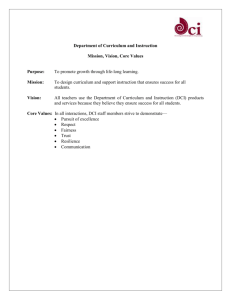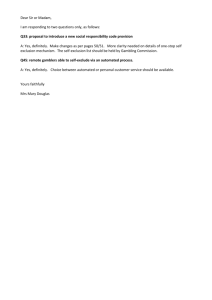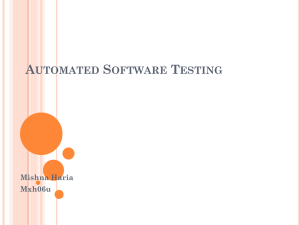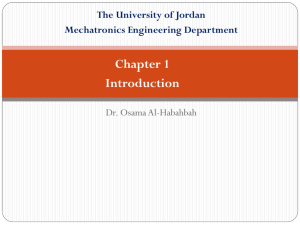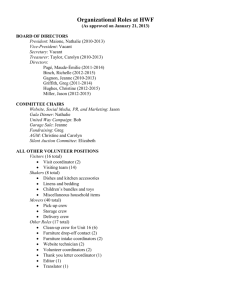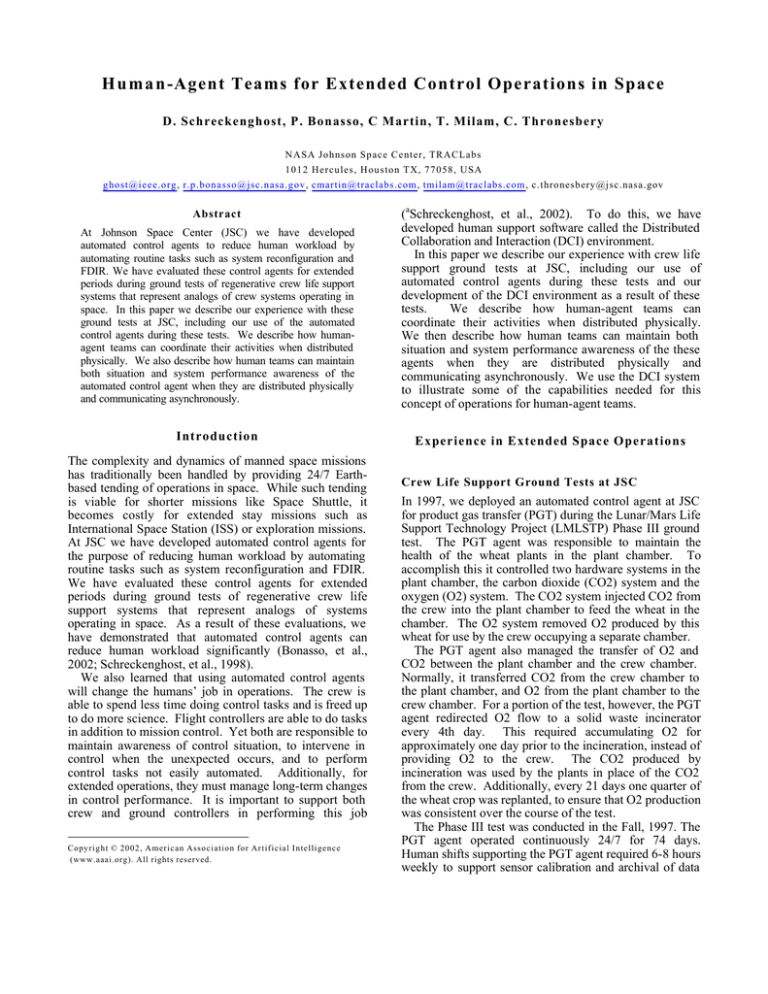
H u m a n -Agent Teams for Extended Control Operations in Space
D. Schreckenghost, P. Bonasso, C Martin, T. Milam, C. Thronesbery
NASA Johnson Space Center, TRACLabs
1012 Hercules, Houston TX, 77058, USA
ghost@ieee.org, r.p.bonasso@jsc.nasa.gov, cmartin@traclabs.com, tmilam@traclabs.com, c.thronesbery@jsc.nasa.gov
At Johnson Space Center (JSC) we have developed
automated control agents to reduce human workload by
automating routine tasks such as system reconfiguration and
FDIR. We have evaluated these control agents for extended
periods during ground tests of regenerative crew life support
systems that represent analogs of crew systems operating in
space. In this paper we describe our experience with these
ground tests at JSC, including our use of the automated
control agents during these tests. We describe how humanagent teams can coordinate their activities when distributed
physically. We also describe how human teams can maintain
both situation and system performance awareness of the
automated control agent when they are distributed physically
and communicating asynchronously.
(aSchreckenghost, et al., 2002). To do this, we have
developed human support software called the Distributed
Collaboration and Interaction (DCI) environment.
In this paper we describe our experience with crew life
support ground tests at JSC, including our use of
automated control agents during these tests and our
development of the DCI environment as a result of these
tests.
We describe how human-agent teams can
coordinate their activities when distributed physically.
We then describe how human teams can maintain both
situation and system performance awareness of the these
agents when they are distributed physically and
communicating asynchronously. We use the DCI system
to illustrate some of the capabilities needed for this
concept of operations for human-agent teams.
Introduction
Experience in Extended Space Operations
Abstract
The complexity and dynamics of manned space missions
has traditionally been handled by providing 24/7 Earthbased tending of operations in space. While such tending
is viable for shorter missions like Space Shuttle, it
becomes costly for extended stay missions such as
International Space Station (ISS) or exploration missions.
At JSC we have developed automated control agents for
the purpose of reducing human workload by automating
routine tasks such as system reconfiguration and FDIR.
We have evaluated these control agents for extended
periods during ground tests of regenerative crew life
support systems that represent analogs of systems
operating in space. As a result of these evaluations, we
have demonstrated that automated control agents can
reduce human workload significantly (Bonasso, et al.,
2002; Schreckenghost, et al., 1998).
We also learned that using automated control agents
will change the humans’ job in operations. The crew is
able to spend less time doing control tasks and is freed up
to do more science. Flight controllers are able to do tasks
in addition to mission control. Yet both are responsible to
maintain awareness of control situation, to intervene in
control when the unexpected occurs, and to perform
control tasks not easily automated. Additionally, for
extended operations, they must manage long-term changes
in control performance. It is important to support both
crew and ground controllers in performing this job
Copyright © 2002, American Association for Artificial Intelligence
(www.aaai.org). All rights reserved.
Crew Life Support Ground Tests at JSC
In 1997, we deployed an automated control agent at JSC
for product gas transfer (PGT) during the Lunar/Mars Life
Support Technology Project (LMLSTP) Phase III ground
test. The PGT agent was responsible to maintain the
health of the wheat plants in the plant chamber. To
accomplish this it controlled two hardware systems in the
plant chamber, the carbon dioxide (CO2) system and the
oxygen (O2) system. The CO2 system injected CO2 from
the crew into the plant chamber to feed the wheat in the
chamber. The O2 system removed O2 produced by this
wheat for use by the crew occupying a separate chamber.
The PGT agent also managed the transfer of O2 and
CO2 between the plant chamber and the crew chamber.
Normally, it transferred CO2 from the crew chamber to
the plant chamber, and O2 from the plant chamber to the
crew chamber. For a portion of the test, however, the PGT
agent redirected O2 flow to a solid waste incinerator
every 4th day. This required accumulating O2 for
approximately one day prior to the incineration, instead of
providing O2 to the crew. The CO2 produced by
incineration was used by the plants in place of the CO2
from the crew. Additionally, every 21 days one quarter of
the wheat crop was replanted, to ensure that O2 production
was consistent over the course of the test.
The Phase III test was conducted in the Fall, 1997. The
PGT agent operated continuously 24/7 for 74 days.
Human shifts supporting the PGT agent required 6-8 hours
weekly to support sensor calibration and archival of data
logs, with an additional 6 hours for each incineration and 3
hours for each harvest (Schreckenghost, et al., 1998).
Product Gas Transfer Automated Control Agent
The PGT agent was developed using the 3T control
architecture (Bonasso, et al, 1997). 3T was developed for
autonomous robots, but was first successfully applied to
the control of life support systems for extended
operations during the Phase III ground test. Since that
time it has been used continuously for over a year to
control a regenerative Water Recovery System(WRS) at
JSC (Bonasso, et al., 2003). The 3T architecture is an
example of a layered control architecture. It consists of
three tiers of control processing that operate in parallel:
• Deliberative Planner: hierarchical task net planner
to manage activities (1) with resources or temporal
constraints, or (2) with multi-agent coordination
• Reactive Sequencer: reactive planner to encode
operational procedures that can be dynamically
constructed based on situational context
• Skill Manager: traditional closed loop control
This approach is designed to handle the uncertainty
inherent in complex domains. Control commands flow
down through the hierarchy and feedback flows back up
through the hierarchy to close the control loop. If a
command fails to succeed at any level, it can initiate a
repair action (e.g., replanning at the deliberative level,
selection of an alternative sequence at the reactive level).
Each layer operates at a different time constant, allowing
high speed controllers at the lowe level of the architecture
to operate in parallel with the slower, deliberative
algorithms at the high level.
Support for Team Interaction
During the Phase III test and subsequent WRS tests, we
provided a variety of support for human interaction during
extended operations with the automated control agents. A
key lesson was the need to assist humans in interleaving
control support with their “other” job. Because the
automated control agent was capable of managing the PGT
or the WRS most of the time, the human support task was
part–time. For these ground tests, engineers needed to
interleave their control support with other tasks on a daily
basis by working operations from their office.
Alternately, this can manifest itself as shift work, where a
person works closely with the system for a period of time
and then shifts to on-call work for a period of time. In
either case, it becomes apparent that the current approach
of dedicated operational support will change. It becomes
necessary to provide assistance in detecting and notifying
people about operational events affecting their assigned
job. Notification should avoid unnecessary interruptions
when possible.
Such event notification can be
complicated by communication latencies (e.g., notice
urgency). Situation summarization becomes essential,
with easy access to the details of the situation on demand.
As mentioned previously, we expect to see in the future
some Earth-based operations supported from offices.
There is also the possibility of multiple sites in space for
exploration missions in the future (e.g., multiple sites on a
planet; an orbiting site and a planetary site). Additionally,
as we design missions that include both humans and
robots, we will see multiple agents conducting concurrent
operations from many locations. Taken together, this
concept of distributed team operations will require
distributed task management among humans and agents. It
will require strategies to adjust autonomy to ensure that
concurrent manual and autonomous operations never
interfere and, in some cases, are closely coordinated. It
will require capabilities for fair allocation of resources
and task responsibilities. This will include strategies to
ensure that tasks are reassigned when contingencies
prevent assigned agents from handling them.
One way to meet these requirements is to develop a
mediating agent that assists humans in interacting with
automated control agents (aSchreckenghost et al, 2002).
We have developed the DCI environment that provides
such a mediating agent, called an ARIEL agent. ARIEL
agents are assigned to each human member of the
operational team. The ARIEL agent can interact with both
control agents and other ARIEL agents. Each ARIEL agent
performs services for its user. The selection of which
services are loaded is configurable for a group. The
services available in the ARIEL agent include: (1) Task
Management, (2) Event Notification, (3) Command
Authorization, and (4) Location Tracking. The DCI
environment also provides these capabilities: (1) Crew
Activity Planner (CAP), (2) Event Detection Assistant
(EDA), and (3) Situation Summarization.
We currently are deploying the DCI System in the
Advanced Water Lab at JSC for evaluation during a ground
test using the Post Processing System (PPS) of the WRS.
The PPS is a water "polisher" used to bring relatively clean
water to within potable limits. It removes the trace
inorganic wastes and ammonium in recycled water using a
series of ion exchange beds and removes the trace organic
carbons using a series of ultraviolet lamps. The DCI
system will provide notification, schedule management,
and situation logging for control engineers.
Coordinated, Distributed Operations
Distributing operations among humans and automated
control agents using the same systems and resources
requires that their activities be coordinated. Such
coordination necessitates that each member of the team is
aware of other team member’s activities and their effects
on system state, especially when transitioning between
manual and automated activities.
Such activity
monitoring also is useful for the human in supervising the
automated control agent. For concurrent activities, it is
important to provide strategies to ensure that ongoing
manual and automated activities do not interfere with each
other. This can be preplanned for all agents or handled
reactively by either adjusting the autonomy level of the
agent or by reassigning the agent’s role. It is undesirable,
however, to achieve this by turning off the automated
agent, since this complicates returning to full autonomy
later. Beyond avoiding interfering actions, agents should
ensure that adequate resources are available to perform
activities. In resource limited environments like space,
this can require resource management planning to ensure
that consumable resources are not over-utilized and that
regenerable resources are produced in adequate quantities.
For extended operations, the configurations of systems,
including the automated control agent, will adjust over
time due to changes in mission priorities resulting from
what is learned in the mission or to workaround the
degraded capability of the equipment. It is necessary
support system reconfiguration activities and to inform
team members when they occur to ensure coordinated
activity. It also is necessary to provide insight into the
configuration of the human-agent team and how it changes
over time to ensure coordinated activity.
In this section we describe how human and agent teams
can coordinate their activities when distributed physically.
We use the DCI system to illustrate some of the
capabilities needed for this concept of operations.
Activity Monitoring
Control automation should be able to track human
activities and the states they affect for coordination with
automated activities.
When human activities are
computer-mediated, they are observable to the control
automation. In some cases, however, human activities are
conducted by direct manipulation of physical devices
(what Martin, et al., 2004, call manual interaction). Such
manual activity can be difficult for automation to observe.
Strategies for tracking manual activities can include
monitoring for direct evidence of manipulation in data
(e.g., valve closed), indirect evidence such as the human
changing location to where the activity will be performed,
or conclusive evidence such as asking for activity
acknowledgement. When combined with knowledge of
the human’s planned activities, this information is an
essential part of executing and updating the plan. When
there is no knowledge about the human’s plans, techniques
for plan recognition are required to utilize the evidence
collected about human activities. In both cases, a model
of the human’s activity (a procedure) is needed.
Similarly, humans should be able to understand the
activities of the control automation and the states they
affect for coordination with human activities. This
requires the control automation to make available to the
user information about its ongoing activities. However,
for extended operations, it is important for the automation
not to become yet another system that the human must
vigilantly monitor. This can be accomplished either by
designing the control agent for supervision (Sheridan,
1992) or by providing a separate, mediating agent between
the human and the control agent responsible for
monitoring the activities of the control agent and drawing
the attention of the human when something important
occurs (aSchreckenghost, et al, 2002).
The ARIEL agent within the DCI system is an example
of such a mediating system. It tracks the activities of its
user. Each activity can have a unique strategy for activity
tracking, such as location tracking or evidence returned
from a crew procedure viewer. Because activity tracking
is never entirely accurate, we are developing techniques
that permit the crew to update task completion
assessments made by the agent. We call this plan
reconciliation. The crew can change the completion
assessment to complete (not considered for replanning) or
not-complete (considered for replanning). The task is
replanned immediately by the CAP if the agent has not yet
marked it complete. The task is replanned at the end of
the day if the agent has already marked it complete.
Concurrent Activity
Coordinated activity requires that concurrent activities not
interfere. This includes human and automated control
activities. It is highly desirable when possible to perform
human operations, such as maintenance or repair, without
shutting down the control automation, permitting
concurrent human and automated operations. This will
likely require, however, some reconfiguration of the
automation to prevent automation from interfering with
the human maintenance or repair activity. For example, a
calibration of the O2 gas analyzer involves, among other
things, the sensor sending high readings. If these high
readings are being processed by the automation during the
calibration, O2 concentration will be activated when none
is needed, pulling down the O2 concentration in the
chamber below acceptable levels. To avoid such errors,
the sensor should be taken offline before calibration.
There many strategies for achieving concurrent manual
and automated operations.
When activities can be
preplanned, a centralized activity planner will ensure that
activities do not conflict. In cases where a more reactive
approach is needed, distributed planning approaches can be
used. Adjustable autonomy techniques enable concurrent
manual and automated operations, and cover a range of
approaches. They can include the reconfiguration of
automation to be less than fully autonomous (Dorais, et
al., 1999). This will affect the agent’s ability to take action
but will not affect its ability to observe (i.e., monitor data
or the actions of others). Adjustable autonomy also can
include the reassignment of roles among agents (Scerri et
al., 2003) in response to changes in situation.
The DCI system has developed an approach for assisting
humans in concurrent commanding of systems normally
managed by automated control agents (Martin, et al.,
2004). The Command and Authorization service
authorizes human commanding if the requested procedure
does not conflict with ongoing activities. It does this by
determining the scope of the effects of the requested
procedure on a system and its constituent subsystems, and
by ensuring that only one person at a time is commanding
within that scope. It also reconfigures the automated
control agent to ensure compliance with the authorization
granted. If the requested procedure conflicts with an
ongoing action, it informs the requestor that authorization
is denied and informs the user about what system states
are in conflict. It permits the user to override the denial in
emergencies. When the user releases authorization, the
agent reconfigures the control agent to its former state.
Resource Management
Coordinating human and agent activities requires ensuring
that adequate resources are available to perform them.
Crew resources include items such as oxygen and water.
Vehicle resources include items such as batteries and fuel.
Typically, these resources are limited. For short duration
operations such as the Space Shuttle, enough resource
must be carried to last for the entirety of the mission. For
extended operations enough resource must be provided
either (1) to last between re-supply missions from Earth
(like ISS), which requires managing resource usage, or (2)
to regenerate resources (e.g., recycle water), which
requires managing both resource production and usage.
Resource availability is usually managed as part of the
planning of both human and automated activities. As such,
the modeling of these activities should include knowledge
of what resources are required to perform the activity.
Resources modeled for planning space activities can
include tools and equipment as well as consumables such
as filters or lubricants. Examples of automated space
planning systems that manage resources include Remote
Agent Planner (Jonsson, et al., 2000) and Aspen (Chien, et
al., 2000). Over extended operation, equipment will wear
out or break, and it becomes important to track the
degradation or loss of resource as part of the resource
model. Similarly the consumption of finite consumables
should be tracked. These changes in the availability or
capability of resources will affect planning.
For
regenerative resources, resource usage should be
predicted, and resource production activities should be
planned. Automation has been used to predict resource
usage and schedule production activities, including crop
scheduling and the scheduling of waste for incineration.
Humans, robots, and software agents also can be viewed
as resources, from an activity planning perspective.
Modeling the skills of these agents permits more
effective workload balancing, and supports plan
adjustment when an agent becomes unavailable or is
needed elsewhere.
For example, the DCI system uses centralized planning
to build multi-day human plans. We model human
activities, including human skills to ensure that tasks are
assigned to qualified personnel, and are investigating
mapping activities in the plan to procedures. We also use
the planner to manage temporal constraints on activities.
For architectures that do not use centralized planning,
the allocation of resource budgets can be combined with
distributed negotiation about resource utilization.
Reconfiguration over Time
Dynamic environments like space require frequent
reconfiguration of both system hardware and software.
This occurs for a variety of reasons, such as (1) mission
phase changes corresponding to operating configuration
changes, (2) reconfiguration of vehicle or crew systems to
support a payload or mission objective, and (3)
reconfiguration of vehicle or crew systems in response to
an anomaly. Such reconfiguration should be coordinated
within the human-agent team to ensure awareness of the
configuration for activities using the affected systems.
Extended operations can raise additional reasons for
reconfiguration. Systems may be reconfigured to support
changes that result from what is learned by conducting the
mission. For example, during Phase III we learned that
residual iodine in the drinking water was not healthy for
the crew. The WRS was reconfigured to add an ion
exchange bed to remove iodine from crew drinking and
food preparation water.
Similarly, for extended
operations, it may not be possible or cost-effective to
repair or replace degraded or broken equipment. In such
cases, systems may be reconfigured to workaround the
degraded capability. During the Phase III ground test, we
discovered that a flow controller had been installed such
that signals were reversed (1 = no flow, 0 = flow). We
avoided reinstallation costs by encoding a workaround
control procedure that adjusted for the reversed signals.
Typically in space operations reconfiguration has meant
changing space systems. But as we distribute teams of
humans, robots, and software agents, reconfiguration also
can refer to a change in the team configuration – its
makeup and the allocation of responsibility among its
members. It becomes important to provide insight into
the configuration of the group and how it changes over
time to assist in team coordination: who the team
members are, what responsibilities they hold (i.e., their
roles), what activities they are performing, and where they
are located. Recent work in context-aware computing
supports the use of participant relationships as a context
for interaction (Tarasewich, 2003). For example, the
ARIEL agent provides information about its user’s role,
location, and activity to other agents for group awareness.
The DCI system has modeled user groups for crew, flight
controller disciplines, and test engineers. The ARIEL
agent provides insight into both the current configuration
and a history of configuration changes for team members.
As control agents are deployed, their configuration will
need to be adjusted over time as well. Some of this
adjustment will result from adaptation to changes required
to control changing crew and vehicle systems. Some will
result from evolution of the software caused by changes in
operations and the discovery of software errors. The
reconfiguration of control agents may also be needed for
fault tolerance over extended operation, particularly with
respect to the degradation of networking and computing
capabilities. For example, the DCI system has been
implemented with software factories that automate much
of the configuration, start up, and shutdown of the DCI
system for a particular deployment. These factories
would be the basis of reconfiguration for fault tolerance.
Remote, Asynchronous Awareness over Time
The distribution of operations out of a centralized control
room to multiple locations (i.e., offices, planetary bases,
space vehicles, surface rovers) necessitates providing new
approaches for maintaining situation awareness. It
introduces the possibility of information latencies and
asynchronous communication, caused both by physical
remoteness as well as human unavailability. When
important operational events occur, the responsible
people should be notified as soon as possible regardless
of location. If the situation worsens, there should be
techniques for escalating the urgency and importance of
the notices. In cases where primary personnel cannot
respond, there should be strategies for automatically
notifying backup personnel. Since people may not always
be accessible, the important information about the event
must be captured and made available for inspection after
the fact. Some of the challenges here are providing easily
understood summaries of the situation that provide ready
access to more detailed information if needed.
In addition to maintaining situation awareness, for
extended operations humans must maintain awareness of
system performance. Performance tends to change
slowly due to small but continuous adjustments as the
system operates. These adjustments result from parts
wearing in and consumables (e.g., filters) wearing out.
There also are environmental considerations (e.g., thermal
stability). Awareness of performance changes is needed
to anticipate hardware degradation before it becomes a
problem as well as to adjust control parameters to changes
in steady-state behavior.
In this section we describe how human teams can
maintain both situation and system performance awareness
of the automated control agent over time when they are
distributed physically and communicating asynchronously.
We use the DCI system to illustrate some of the
capabilities needed for this concept of operations.
Situation Awareness
Endsley (2001) states that "situation awareness is the (1)
perception of the elements in the environment within a
volume of time and space, (2) the comprehension of their
meaning, and (3) and the projection of their status in the
near future." With this in mind, the elements of the
control environment are information about system
configuration and status changes, system anomalies, and
the impact of these anomalies on operations and crew. To
make these elements comprehensible, they must be
accessible to a distributed operational team, some of
whom are inaccessible at times. Thus mechanisms should
be provided for automatically detecting important events,
notifying team members about these events, and providing
access to additional information about the associated
operational situation should it be needed.
If possible, the user should be able to choose when to
review the information to avoid unnecessary distraction.
In some cases, however, information is sufficiently urgent
or important that the user’s attention should be focused on
an event when it occurs. To illustrate, in the DCI system,
the ARIEL agent uses knowledge of its user’s role to
determine whether an incoming event from the control
agent is of interest. It determines how to inform its user
based on the tolerance for information latency, the need to
focus the user’s attention on the incoming information,
and the user’s availability (bSchreckenghost, et al, 2002).
Events passed to the human can come directly from the
automated control agent. In the ground tests, the control
agent sent notices when it reconfigured the system, when
an anomaly occurred, and when it took anomaly response
actions. One of the challenges for the control agents is
providing the user with useful information about the
domain system without excessive processing overhead,
because software implementation models may not match
human models of operation.
To offload some of this processing, events also may be
provided to the human by an intermediate process that
monitors information from the control agent. An example
of such a process is the EDA in the DCI system. The EDA
computes Caution & Warning events and failure impacts
(e.g., rising CO2 when CO2 removal system is shutdown)
using pattern-matching software.
Many operational situations develop over time as a
progression of simpler events. For extended operations, it
is especially important to capture these events as they
occur for inspection after the fact, including comparison
to similar events in the future. In the DCI system, we use
the Complex Event Recognition Architecture (CERA)
(Fitzgerald, et al., 2004) to capture complex events that
we call situation objects. CERA applies natural language
parsing techniques to detect event patterns with complex
temporal and hierarchical relationships among them.
These situation objects encapsulate the events describing
important operational situations in space systems, such as
a loss of communication anomaly or a bioreactor slough
maintenance activity. In DCI we have developed a XML
data structure for life support situations and a generalized
viewer for this data structure (Thronesbery and
Schreckenghost, 2003). These situations are accessed and
logged as notices in the ARIEL agent.
System Trends and Performance
An essential aspect of system awareness over extended
operation is knowledge of system performance and trends
over time. This knowledge is typically not characterized
by specific situations. Instead, it is collective knowledge
often described statistically. Control performance can be
characterized at many levels:
• component level: changes in the hardware
•
•
system (e.g., biases, drifts on parameters)
process level: changes in the configuration of
software and hardware (e.g., connectivity, flow)
product level: changes in the production or
consumption of resource (e.g., production rate)
In the DCI system we use the CERA system to capture
daily performance objects for the PPS. The information
that we capture is a mix of component and product level
information, and includes the following:
• % change in bed ion loading (ion exchange beds
•
remove trace inorganic wastes and ammonium)
average power used to run system
•
minimum and maximum total organic carbon
(TOC), and time periods in which TOC was hig
We are evaluating this object in the PPS ground test.
Tracking parameter changes over time (called trending)
has long been an operational technique employed by
controllers in manned space operations. Strip charts and
real-time plots are used as visual predictors of system
behavior. For example, one can see a device going out of
limits (e.g., engine overheating) and often can predict
when it will reach the limit. Real-time trending, and the
ability to interpret trends, is a commonly requested
capability for operations. One of the challenges of
automating such support, however, is that the
interpretation of these trends is very situation-specific.
Additionally, when system behaviors are coupled,
conclusive interpretation of trends can be difficult.
Conclusions
Introducing automated control agents into manned spaced
operations will result in a distributed human-agent team.
Automated control agents will operate autonomously in
space most of the time. Crew will interact with them for
maintenance tasks. Flight controllers will monitor their
performance to anticipate problems. If problems occur,
both crew and ground may be involved to resolve them.
This distributed human-agent team will require new
ways of working together. To address this we first
described how humans and automated control agents
activities can be coordinated. This includes maintaining
awareness of team member activities, providing strategies
to avoid interfering activities and to take required actions
when tighter coordination is needed, ensuring adequate
resources are available, and maintaining awareness of
system and team reconfiguration over time. Next we
discussed maintaining awareness of both situation and
system performance as it changes over time.
We also have proposed that another type of agent, a
mediating agent to assist humans in performing distributed
operations, is useful. We justify this claim based on our
experience in the JSC ground tests. We have developed a
prototype of such an agent as part of the DCI system. The
ARIEL agent provides services such as event notification,
task management, command authorization, and location
tracking to assist its user. We are currently evaluating the
DCI system during a ground with WRS control engineers.
Acknowledgements
We acknowledge the support of Dr Michael Shafto,
manager of Human-Centered Computing in NASA’s
Intelligent Systems Program, who sponsored this work.
References
Bonasso, P., Firby, J., Gat, E., Kortenkamp, D., Miller, D, and
Slack, M. 1997a. Experiences with an Architecture for
Intelligent, Reactive Agents. Journal of Experimental Theory
of Artificial Intelligence. 9: 237-256
Dorais, G., Bonasso, R. P., Kortenkamp, D., Pell, B., and
Schreckenghost, D. Adjustable autonomy for human-centered
autonomous systems. Proceedings of Adjustable Autonomy
Workshop. International Joint Conference on Artificial
Intelligence (IJCAI) Aug 1999.
Bonasso, R. P., Kortenkamp, D., and Thronesbery, C. 2003.
Intelligent Control of A Water Recovery System: Three years in
the Trenches. AI Magazine 24 (1): 19-44.
Chien, S., G. Rabideau, R. Knight, R. Sherwood, B. Engelhardt, D.
Mutz, T. Estlin, B. Smith, F. Fisher, T. Barrett, G. Stebbins, D.
Tran , "ASPEN - Automating Space Mission Operations using
Automated Planning and Scheduling," SpaceOps 2000,.
Endsley, M. Designing for Situation Awareness in Complex
Systems. Proceedings of Second International Workshop on
Symiosis of Humans, Artifacts, & Environment. Japan. 2001.
Fitzgerald, W., R. J. Firby, A. Phillips, J. Kairys. Complex Event
Pattern Recognition for Long-Term System Monitoring. AAAI
Spring Symposium 2004 on Interaction between Humans &
Autonomous Systems over Extended Operation Stanford
Univ., Palo, Alto, CA. Mar 2004.
Jonsson, Morris, Muscettola, Rajan, and Smith. Planning in
Interplanetary Space: Theory and Practice. Proceedings of the
Fifth International Conference on Artificial Intelligence
Planning Systems, Breckenridge, CO. April, 2000.
Martin, C., Schreckenghost, D., Bonasso, P. Augmenting
Automated Control Software to Interact with Multiple Humans.
AAAI Spring Symposium 2004 on Interaction between
Humans & Autonomous Systems over Extended Operation
Stanford Univ., Palo, Alto, CA. Mar 2004.
Scerri, P., L. Johnson, D. Pynadath, P. Rosenbloom, N. Schurr, M.
Si and M. Tambe. Getting Robots, Agents and People to
Cooperate: An Initial Report. AAAI Spring Symposium on
Human Interaction with Autonomous Systems in Complex
Environments. March 2003.
Schreckenghost D.; Ryan, D.; Thronesbery, C.; Bonasso, P.; and
Poirot, D. Intelligent control of life support systems for space
habitats. AAAI IAAI 1998. Madison, WI. July 1998.
a
Schreckenghost, D, Thronesbery, C., Bonasso, P., Kortenkamp,
D., and Martin, C. 2002. Intelligent Control of Life Support for
Space Missions. IEEE Intelligent Systems 17 (5): 24-31.
b
Schreckenghost, D.,C. Martin, and C. Thronesbery. Specifying
Organizational Policies and Individual Preferences for Human
Software Interaction. Proceeding AAAI 2002 Fall Symposium
on Etiquette for Human-Computer Work. Nov 2002.
Sheridan, T. Telerobotics, automation, and human supervisory
control. MIT Press. Cambridge, MA, USA . 1992.
Thronesbery, C., and Schreckenghost, D., Situation Views: Getting
Started Handling Anomalies. IEEE International Conf on
Systems, Man, & Cybernetics. Wash, D. C. 2003
Tarasewich, P. Towards a Comprehensive Model of Context for
Mobile and Wireless Computing. Proceedings of the AMCIS
2003 Conference, 114-124.

